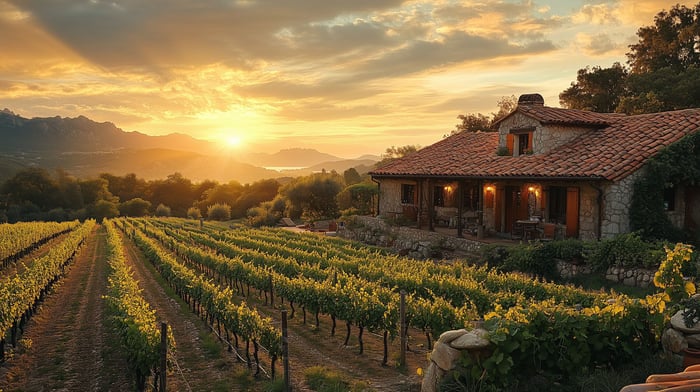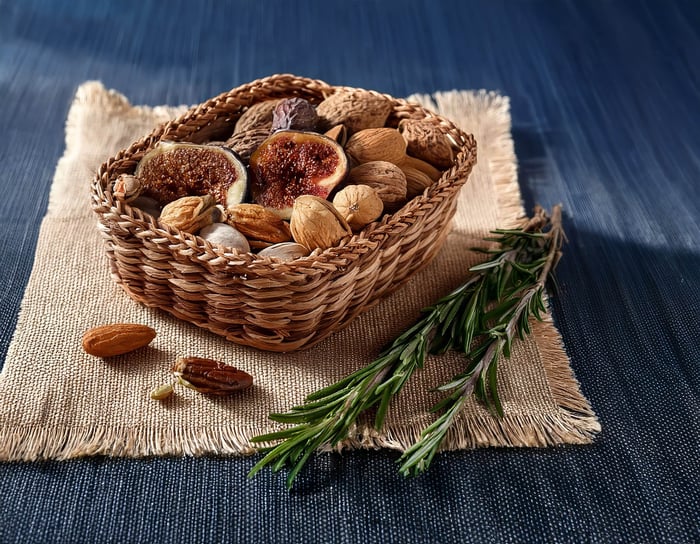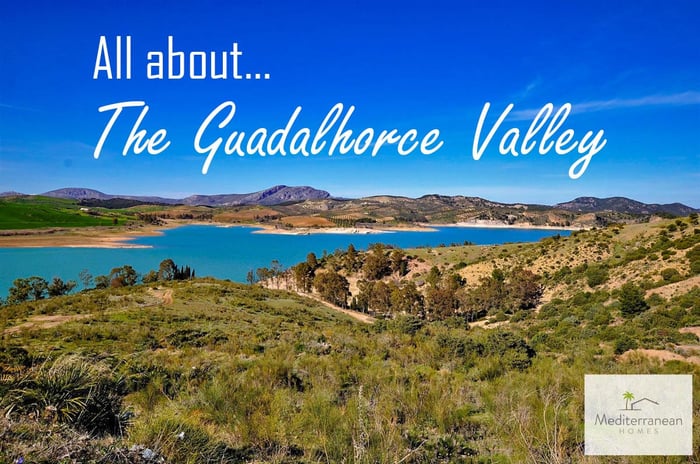Table of Contents
- Evolution of Fincas in Andalusia
- What to Plant on Your Finca – and When
- Buying Lemon or Olive Trees: What to Look For
- Vegetables
- Herbs and Medicinal Plants
- Seasonal Calendar Snapshot
- A Client Story
- Where to Buy Trees, Seeds, and Plants Locally
- Practical Tips for New Finca Owners
- Installing a Legal Water Well on Your Finca in Andalusia
- Common Challenges and Solutions
- Final Thought
Dreaming of a life surrounded by olive trees, sun-ripened fruit, and the tranquil beauty of the Spanish countryside? Whether you’re considering buying a finca in Spain or searching for a finca for sale in Andalusia, cultivating your own Mediterranean orchard and vegetable garden is one of the most rewarding ways to embrace a sustainable finca lifestyle. Here in the Guadalhorce Valley, the fertile land invites you to experience living off the land in Andalusia and creating a home rooted in abundance.
Here in Andalusia, and particularly in the fertile Guadalhorce Valley, you’ll find an ideal climate for growing a huge variety of vegetables, herbs, and Mediterranean fruit trees. From organic gardening in Spain to planting your first olive grove, this region is perfect for creating a Mediterranean orchard and an abundant Andalusian vegetable garden.
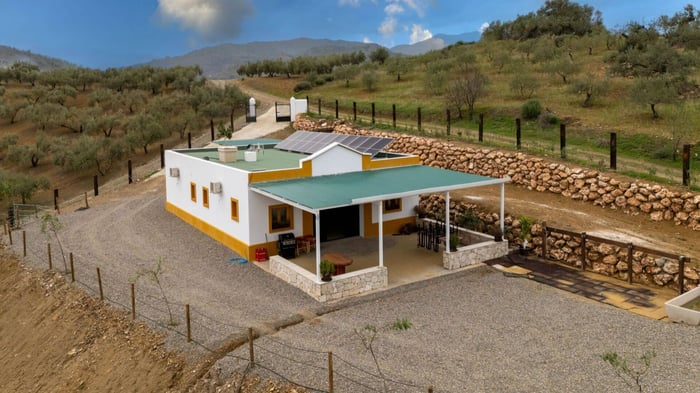 To whet your appetite: a lovely example of a typically traditional Spanish finca that is currently for sale in Guaro. Idea for anyone looking to keep horses! View more about this property
To whet your appetite: a lovely example of a typically traditional Spanish finca that is currently for sale in Guaro. Idea for anyone looking to keep horses! View more about this property
Evolution of Fincas in Andalusia
Early Origins
The concept of the finca (a rural estate, often including farmland and a farmhouse) in Andalusia dates back to the Moorish period (8th–15th centuries), when the region’s fertile valleys were developed into agricultural hubs. Moorish settlers introduced advanced irrigation systems (acequias) and terracing, enabling crops such as olives, grapes, citrus, and almonds to flourish. Fincas were working farms, typically self-sufficient, with the farmhouse serving as both residence and agricultural storehouse.
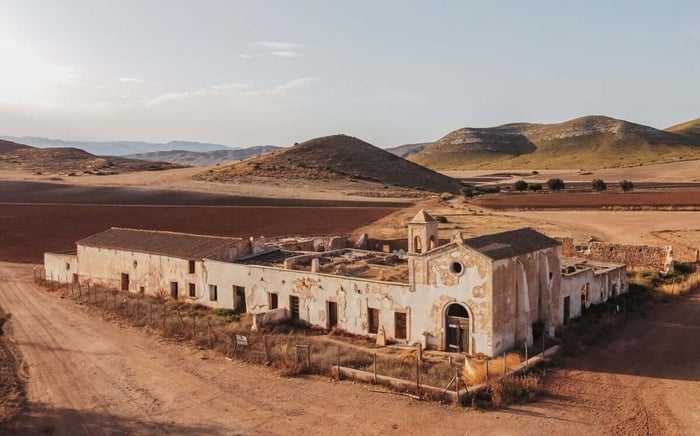 Aerial image of an abandoned cortijo in Almeria, Spain.
Aerial image of an abandoned cortijo in Almeria, Spain.Post-Reconquista (15th–18th centuries)
After the Christian reconquest in 1492, many fincas became part of large estates owned by nobility or wealthy families, run by tenant farmers or labourers. These estates often grew olives, cereals, and wine grapes for local consumption and trade, with the farmhouse (cortijo) built in a practical, fortified style to protect resources.
19th–Early 20th Century
Mechanisation was slow to arrive; most fincas were worked by hand or animal power. Rural communities often centred around these estates, with seasonal workers moving between fincas for harvests. In the early 20th century, agricultural reform laws began redistributing land in some areas, creating more independently owned smallholdings.
Mid–Late 20th Century
Industrialisation and migration to cities led to rural depopulation, with many fincas falling into disuse or being abandoned. At the same time, improvements in road networks and water supply made rural living more accessible, prompting some urban residents to restore fincas as weekend or holiday homes.
Modern Day
Today, many fincas in Andalusia still function as working farms, particularly for olives, vineyards, and organic produce. Others have been restored as luxury homes, boutique hotels, wedding venues, or rural tourism rentals, blending traditional Andalusian architecture with modern comforts. In recent years, there has been a revival of interest in sustainable farming and self-sufficient living, with some fincas incorporating eco-friendly designs, renewable energy, and permaculture.
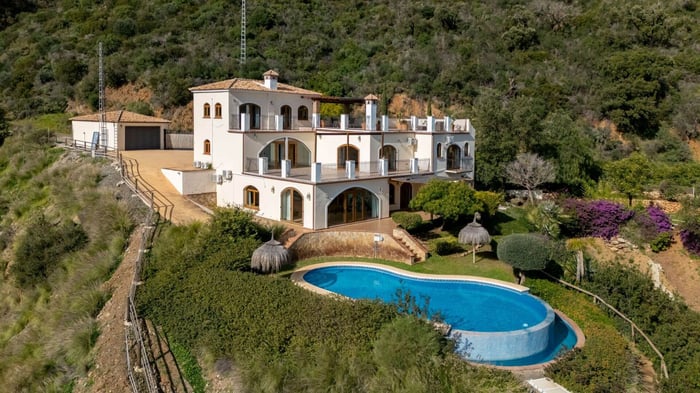 Example of a renovated finca in Coin, Spain. This finca is currently for sale with Mediterranean Homes! View more information and photos
Example of a renovated finca in Coin, Spain. This finca is currently for sale with Mediterranean Homes! View more information and photosWhat to Plant on Your Finca – and When
Below is a selection of beneficial foods and plants perfect for Mediterranean climates, along with suggested planting times to help you plan your orchard and garden.
Fruit Trees
Olive Trees (Aceitunas)
Why: Drought-tolerant, produce oil and table olives.
Planting: November–March (dormant season)
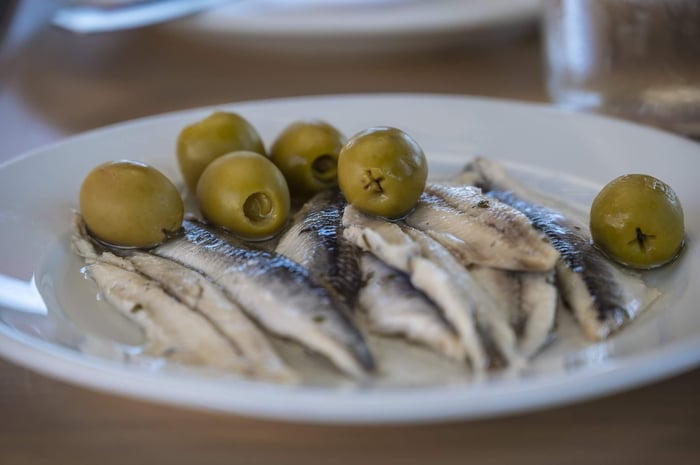
Climate Needed:
Hot, dry summers & mild winters. Needs full sun, drought-tolerant once established.
Time to Fruit:
- Grafted trees: 3–5 years after planting
- From seed: 8–10+ years, if ever (seedlings often revert to wild type)
- Harvest: Late autumn to early winter (variety-dependent)
- Green olives picked early (Sept–Oct), black olives left until later (Nov–Jan)
- Lifespan: Hundreds of years – they’re long-living and hardy
Harvest Tip: Olives must be processed/cured before eating. You can brine, dry-salt, or lye-treat them.
Raw olives straight from the tree are bitter and inedible due to a compound called oleuropein, so they must be cured before eating. Here’s a breakdown of the three most common home-curing methods:
1. Brine Curing (Saltwater Method)
Best for: Black or green olives
Taste: Mild, salty, traditional
What You Need: Fresh olives
- Water, Salt (non-iodised, like sea salt or pickling salt)
- Glass jars or food-grade buckets
How to Sort and Clean Your Olives.
- Discard bruised or damaged ones.
- Score or crush the olives (optional but speeds up the process).
- Make a 10% saltwater brine (100g salt per litre of water).
- Place olives in the brine. Make sure they’re fully submerged (use a weight or plate).
- Change the brine every 1–2 weeks to reduce bitterness.
- Cure for 4–6 weeks (green olives) or 2–3 months (black olives).
Once bitterness is gone, store in fresh brine or marinate in olive oil, garlic, herbs, etc.
2. Dry Salt Curing (For Black Olives Only)
Best for: Ripe black olives
Taste: Intense, shrivelled, wrinkled — “oil-cured” texture
What You Need: Ripe black olives
- Coarse sea salt, A crate or basket (with airflow), and cloth towels or paper
- How To: Layer olives and salt in a basket: 1 layer of olives, 1 layer of salt.
- Cover and store in a cool, dry, ventilated place.
- Stir every few days, adding more salt if needed.
- After 4–6 weeks, olives will shrink and darken.
- Rinse thoroughly, dry, and store in olive oil.
3. Lye Curing (Quickest but more chemical)
Best for: Green olives
Taste: Smooth, firm, often supermarket-style
What You Need:
- Fresh green olives
- Food-grade lye (sodium hydroxide)
- Gloves, eye protection, and extreme caution
- Water, salt, vinegar (optional)
How to Mix Lye Solution:
- 1 tablespoon of lye per litre of water (follow instructions precisely).
- Add olives and soak for 12–24 hours (watch closely).
- Rinse multiple times with fresh water (3–4 days) until completely clear.
- Soak in brine for 2–4 weeks to restore flavour.
Optional: Add garlic, lemon, or herbs for taste.
⚠️ Lye is caustic — use gloves, eye protection, and avoid metal containers.
✅ Taste Test: Always taste a few before stopping the curing process. They should be not bitter, salty, and edible — adjust curing time if needed.
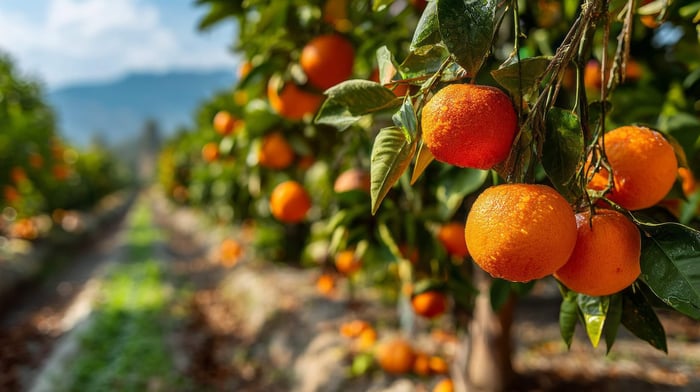
Citrus (Orange, Lemon, Mandarin)
Why: Beautiful evergreen trees with vitamin-rich fruit.
Planting: Late winter–early spring (February–April)
Lemon Trees (Citrus limon)
Climate Needed: Prefers warm, frost-free areas. It can be grown in pots and brought indoors in winter in colder regions.
- Time to Fruit: Grafted trees:
- 1–3 years after planting
- From seed: 5–7+ years (not recommended for fruiting)
- Fruit Season: Depending on variety:
- Eureka & Lisbon: Mainly winter/spring
- Meyer lemon: Multiple crops a year, often spring and autumn
- Lifespan: 50+ years with good care
Harvest Tip:
Lemons can stay on the tree for weeks after ripening. Harvest when they’re fully yellow and slightly soft when squeezed.
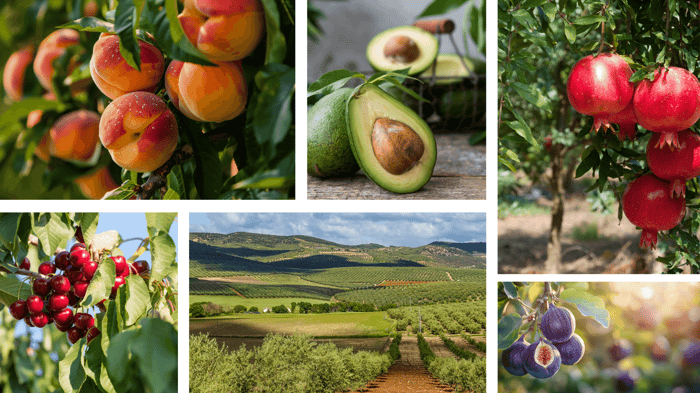
Almond Trees (Prunus dulcis)
Why: Early blossoms, great for pollinators, and healthy nuts.
- Buy at age: 1–2 years old (bare root or potted, grafted).
- Time to fruit: 3–5 years.
- Planting time: December–February (dormant season).
- Harvest time: August–September
- Expected yield: After 5 years: 5–10 kg nuts/tree
- Full maturity: 15–30 kg/tree
✅ Needs two varieties for good pollination (unless self-fertile).
✅ Top 2 Almond Varieties for Spain
1. ‘Guara’
Origin: Spain
- Pollination: Self-fertile (no pollinator needed, but yield improves with another variety)
- Bloom Time: Late (helps avoid frost damage)
- Fruit: Medium-sized, sweet kernel, semi-hard shell
- Advantages: Excellent choice for home growers
- Consistent yield and low maintenance
Resistant to many diseases and pests
✅ Often used by commercial orchards in Andalucía and Valencia.
2. ‘Ferragnès’
- Origin: France
Pollination: Needs a pollinator — works perfectly with Guara - Bloom Time: Mid-late
- Fruit: Large nuts, hard shell, excellent flavour
- Advantages: High-yielding
- High market value due to quality
- Pairs well with most late-flowering cultivars like Guara or Marta
- Bonus: Ferragnès produces abundant blossoms — great for pollinators like bees.
- Alternative Pollinators (if Guara not available):
- Marta: Self-fertile Spanish variety, late flowering
- Lauranne: French, needs cross-pollination, late blooming, very productive
Planting Tip (for Pollination Success):
- Plant Guara and Ferragnès no more than 20–25 metres apart
- Encourage bees: grow lavender, rosemary, or thyme nearby
Fig Trees (Ficus carica)
Why: Low maintenance, loves heat, produces sweet fruit.
- Buy at age: 1–2 years old (potted or bare root).
- Time to fruit: 1–2 years after planting.
- Planting time: February–April
- Harvest time: Breba crop (on last year’s wood): June
- Main crop (on new growth): August–September
- Expected yield: 25–50 fruits per tree (young), 100+ when mature.
✅ Needs space or container root restriction to encourage fruiting.
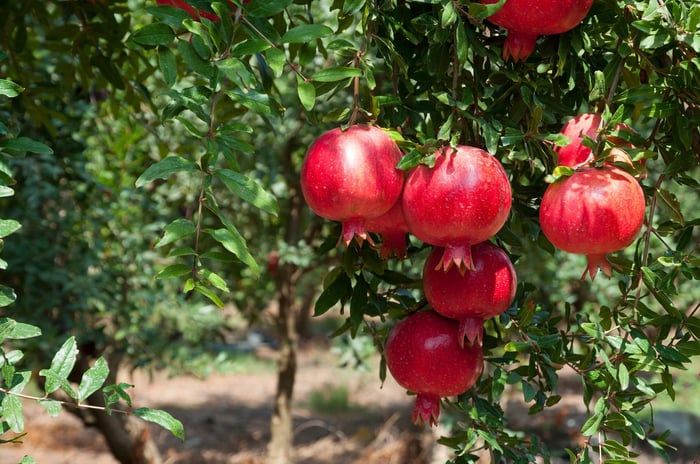
Pomegranate Trees (Punica granatum)
Why: High in antioxidants, drought-tolerant, beautiful flowers.
- Buy at age: 1–2 years old (potted preferred).
- Time to fruit: 2–3 years after planting.
- Planting time: February–April
- Harvest time: September–November
- Expected yield:
- Young: 5–10 fruits
- Mature: 20–50+ fruits/tree
✅ Self-fertilising but planting two can increase yield.
Buying Lemon or Olive Trees: What to Look For
- Age to Buy: Most people buy 2 to 3-year-old trees. These are typically:
- Established in pots or containers (5–15 litres)
- Have a solid root system
- Ready to be transplanted into the ground or a larger pot
- Where to Buy: Local nurseries (often grafted and climate-suitable)
- Online tree suppliers (look for disease-free, certified sources)
Specialist Mediterranean plant nurseries if you're in a warm climate like Spain or the southern UK
Vegetables
If you're growing your own food or planning a Mediterranean-style garden in Spain, timing is everything. In this guide, we break down exactly when to plant, what to plant, and when to harvest some of the most rewarding fruit trees and vegetables suited to the Spanish climate — including lemons, olives, almonds, figs, pomegranates, and staple veg like tomatoes, peppers, courgettes, leafy greens, onions, and garlic. Whether you're new to gardening or refining your seasonal strategy, this is your no-nonsense, climate-smart planting calendar.
Tomatoes, Peppers, Aubergines (Eggplants)
Planting Schedule
Seed indoors: January–February
Transplant outdoors: March–April (after frost risk)
Harvest:
- Tomatoes: June–September
- Peppers: July–October
- Aubergines: July–October
Climate Needs
- Full sun, warm soil (20–30°C)
- Well-drained soil with compost
Varieties for Spain - Tomatoes: ‘Marmande’, ‘Muchamiel’, ‘Corazón de Buey’
- Peppers: ‘Padrón’, ‘Lamuyo’, ‘Italian Sweet’
- Aubergines: ‘Listada de Gandía’ (striped), ‘Black Beauty’
✅ Tip: Harden off seedlings 7–10 days before transplanting outdoors.
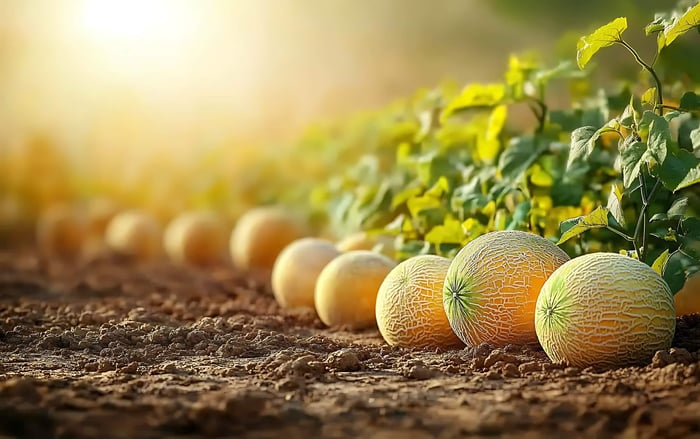
Courgettes (Zucchini) & Melons
Planting Schedule
- Direct sow or transplant: April–June
- Harvest: Courgettes: June–September (harvest every 2–3 days for best taste)
- Melons: July–September
Climate Needs
- Loves heat (25–35°C), needs consistent watering
- Space well to prevent mildew
Varieties for Spain
- Courgettes: ‘Verde de Milán’, ‘Clarita’
- Melons: ‘Piel de Sapo’, ‘Galia’, ‘Canteloupe Charentais’
✅ Tip: Use mulch to retain moisture and reduce fungal risk.
Leafy Greens (Lettuce, Spinach)
Planting Schedule
Main sowings:
- Autumn: September–October
- Early Spring: February–March
Harvest:
- 4–8 weeks after sowing
- Cut-and-come-again varieties allow multiple harvests
Climate Needs:
- Prefers cooler weather (10–20°C)
- Bolts quickly in heat — choose bolt-resistant varieties
Varieties for Spain:
- Lettuce: ‘Maravilla de Verano’, ‘Romana’, ‘Batavia’
- Spinach: ‘Gigante de Invierno’, ‘Matador’
✅ Tip: Use shade cloth if planting late spring to prevent bolting.
Onions & Garlic
Planting Schedule
- Planting: October–December
Harvest:
- Garlic: May–June
- Onions: June–July (green onions earlier)
Climate Needs
- Needs cool early growth, then warm dry conditions to mature
- Well-drained soil, full sun
Varieties for Spain
- Garlic: ‘Ajo Morado’, ‘Ajo Blanco’, ‘Chileno’
- Onions: ‘Babosa’, ‘Reca’, ‘Grano de Oro’
✅ Tip: Stop watering 2–3 weeks before harvest to allow curing in the ground.
Herbs and Medicinal Plants
If you’re looking to grow hardy, low-maintenance plants that thrive in the Mediterranean climate and offer both culinary and medicinal benefits, herbs like rosemary, thyme, oregano, and lavender, along with the soothing aloe vera, are excellent choices. These plants not only handle Spain’s sun and dry conditions with ease, but they also provide year-round value in the kitchen, the medicine cabinet, and the garden itself. Here's everything you need to know to get started.
Rosemary (Rosmarinus officinalis)
- Planting time: March–May (from cuttings or small plants)
- Sunlight: Full sun
- Soil: Well-drained, sandy or loamy; low fertility
- Watering: Very drought-tolerant; water only when soil is dry
- Harvest: Spring through autumn — cut sprigs as needed
- Lifespan: Long-lived perennial (10–20 years)
- Uses: Culinary herb, antiseptic, improves memory, aids circulation, insect-repellent properties
Thyme (Thymus vulgaris)
- Planting time: March–May (seeds, cuttings, or divisions)
- Sunlight: Full sun
- Soil: Light, rocky or sandy, well-drained
- Watering: Moderate; do not overwater, prefers dry spells
- Harvest: Spring to autumn — best before flowering
- Lifespan: Perennial (up to 5–6 years with good care)
- Uses: Antibacterial, cough relief, digestive aid, powerful culinary flavouring
Oregano (Origanum vulgare)
- Planting time: March–May (from cuttings or small nursery plants)
- Sunlight: Full sun
- Soil: Well-drained, neutral to alkaline
- Watering: Minimal; allow soil to dry out between watering
- Harvest: Late spring to early summer — just before flowering for best flavour
- Lifespan: Hardy perennial (5–10 years)
- Uses: Culinary herb, antifungal, immune-boosting, respiratory aid
Lavender (Lavandula angustifolia or L. dentata)
- Planting time: Spring or autumn
- Sunlight: Full sun
- Soil: Sandy, well-drained, slightly alkaline preferred
- Watering: Water deeply but infrequently; hates wet roots
- Harvest: Mid to late summer — cut flower stalks when just blooming
- Lifespan: Long-lived perennial (10+ years with pruning)
- Uses: Aromatherapy, calming, antiseptic, insect repellent, herbal tea
Aloe Vera (Aloe barbadensis miller)
- Planting time: Spring (from pups or potted plant)
- Sunlight: Full sun (some shade in extreme heat)
- Soil: Very well-drained, cactus or sandy soil mix
- Watering: Very low; allow soil to fully dry before watering
- Harvest: Anytime — remove outer leaves as needed
- Lifespan: Perennial succulent (5–15 years)
- Uses: Skin burns, sunburn, cuts, digestion, natural anti-inflammatory, soothing gel
Seasonal Calendar Snapshot
| Season | Best Crops to Plant |
| Spring | Citrus trees, tomatoes, peppers, herbs |
| Summer | Melons, squash, aubergine |
| Autumn | Leafy greens, late garlic, lavender |
| Winter | Olives, almonds, onions, garlic |
A Client Story
One of our recent clients from the UK purchased a finca in the Guadalhorce Valley, fulfilling their dream of owning a Mediterranean finca and creating a thriving vegetable garden in Andalusia.
Within the first year, they transformed their property into a vibrant organic orchard filled with citrus and olive trees, a raised-bed vegetable garden, and a small patch of aromatic herbs.
They told us:
“We’ve never felt so connected to the seasons. The first time we picked our own oranges, we finally felt like we were truly living off the land in Andalusia.”
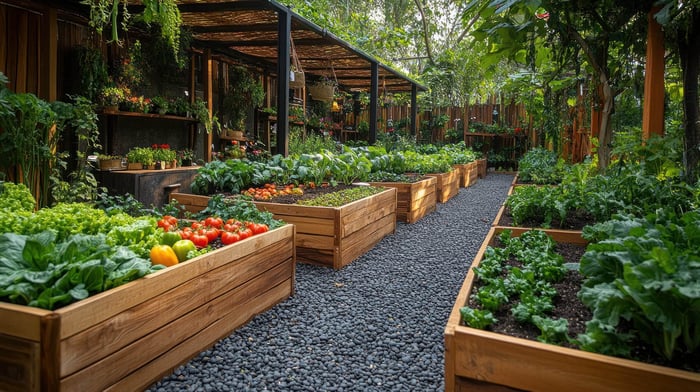
Where to Buy Trees, Seeds, and Plants Locally
If you’d like to create your own Mediterranean orchard, here are some trusted nurseries and suppliers:
Where to Buy Trees, Seeds, and Plants in the Guadalhorce Valley
If you’re planning to create your own Mediterranean orchard or vegetable garden, here are some trusted nurseries and suppliers our clients often use when buying a finca in Spain:
Vivero Casa De Las Flores - This garden centre has a great choice of plants and trees as well as pots, materials for watering systems etc. They also sell house plants
Viveros Santana - A family-run nursery in Coín offering fruit trees, Mediterranean shrubs, and gardening supplies.
Viveros El Algarrobo - Specialists in mature olive trees and fruit trees adapted to the Andalusian climate.
Planfor España - Online store with a large range of fruit trees, berry bushes, and Mediterranean plants delivered to your door.
Note: Mediterranean Homes is not affiliated with these companies; we share these resources for informational purposes only.

Practical Tips for New Finca Owners
Water Management: Install drip irrigation or rainwater tanks to cope with long dry spells.
Soil Health: Enrich the soil with organic compost and mulch.
Shade and Wind Protection: Young trees benefit from shade netting and windbreaks.
Legal Considerations: Check local regulations before planting commercial quantities.
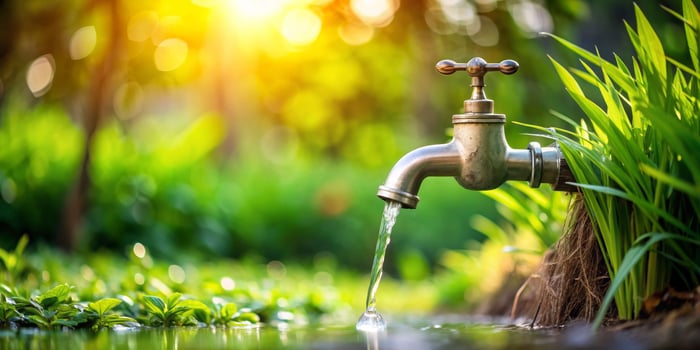
Installing a Legal Water Well on Your Finca in Andalusia
Spain’s severe water scarcity—especially across the drought-prone southern regions—has led to much stricter regulations on well drilling. Many finca and rural property owners don’t realise that installing a well without the proper permits can result in significant fines and even legal action. Before you consider drilling, it’s essential to understand the official requirements, apply for the necessary authorisations, and ensure your well complies with both regional and national water laws.
For a full guide on permits, regulations, and how to avoid fines, read our complete article on Well Drilling and Legal Requirements in Southern Spain.
Common Challenges and Solutions
Heatwaves: Mulch generously and water early in the morning.
Pests: Use organic deterrents or companion planting.
Poor Soil: Amend with manure and compost each season.
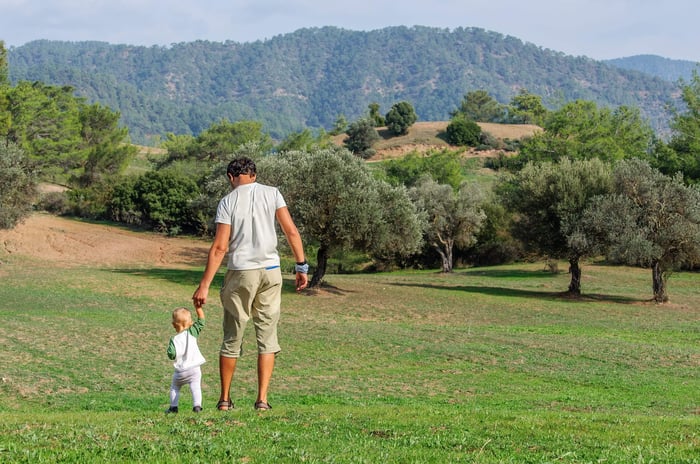
Final Thought
Whether you’re dreaming of buying a finca in Spain, searching for a finca for sale in Andalusia, or already nurturing your own slice of paradise, creating a sustainable finca lifestyle is one of the most rewarding choices you can make.
With the right property, you can enjoy living off the land in Andalusia, establishing your own Mediterranean orchard, and growing fresh produce in your Andalusia vegetable garden. Here in the Guadalhorce Valley, the fertile land and mild climate make it easy to grow fresh produce, establish a thriving vegetable garden, and start planting a Mediterranean orchard that will feed your family for generations.
If you long for a slower pace and the freedom of living off the land in Andalusia, your finca can become a sanctuary of abundance, wellbeing, and connection to nature. Discover how the right Guadalhorce Valley property can help you turn this vision into reality and let Mediterranean Homes guide you every step of the way.

